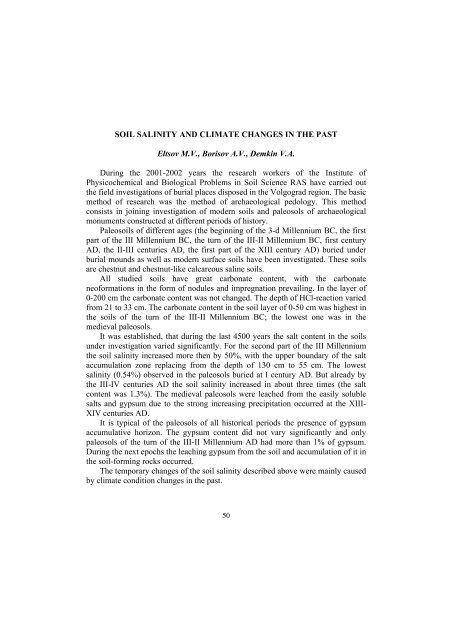C - Lublin
C - Lublin
C - Lublin
Create successful ePaper yourself
Turn your PDF publications into a flip-book with our unique Google optimized e-Paper software.
SOIL SALINITY AND CLIMATE CHANGES IN THE PAST<br />
Eltsov M.V., Borisov A.V., Demkin V.A.<br />
During the 2001-2002 years the research workers of the Institute of<br />
Physicochemical and Biological Problems in Soil Science RAS have carried out<br />
the field investigations of burial places disposed in the Volgograd region. The basic<br />
method of research was the method of archaeological pedology. This method<br />
consists in joining investigation of modern soils and paleosols of archaeological<br />
monuments constructed at different periods of history.<br />
Paleosoils of different ages (the beginning of the 3-d Millennium BC, the first<br />
part of the III Millennium BC, the turn of the III-II Millennium BC, first century<br />
AD, the II-III centuries AD, the first part of the XIII century AD) buried under<br />
burial mounds as well as modern surface soils have been investigated. These soils<br />
are chestnut and chestnut-like calcareous saline soils.<br />
All studied soils have great carbonate content, with the carbonate<br />
neoformations in the form of nodules and impregnation prevailing. In the layer of<br />
0-200 cm the carbonate content was not changed. The depth of HCl-reaction varied<br />
from 21 to 33 cm. The carbonate content in the soil layer of 0-50 cm was highest in<br />
the soils of the turn of the III-II Millennium BC; the lowest one was in the<br />
medieval paleosols.<br />
It was established, that during the last 4500 years the salt content in the soils<br />
under investigation varied significantly. For the second part of the III Millennium<br />
the soil salinity increased more then by 50%, with the upper boundary of the salt<br />
accumulation zone replacing from the depth of 130 cm to 55 cm. The lowest<br />
salinity (0.54%) observed in the paleosols buried at I century AD. But already by<br />
the III-IV centuries AD the soil salinity increased in about three times (the salt<br />
content was 1.3%). The medieval paleosols were leached from the easily soluble<br />
salts and gypsum due to the strong increasing precipitation occurred at the XIII-<br />
XIV centuries AD.<br />
It is typical of the paleosols of all historical periods the presence of gypsum<br />
accumulative horizon. The gypsum content did not vary significantly and only<br />
paleosols of the turn of the III-II Millennium AD had more than 1% of gypsum.<br />
During the next epochs the leaching gypsum from the soil and accumulation of it in<br />
the soil-forming rocks occurred.<br />
The temporary changes of the soil salinity described above were mainly caused<br />
by climate condition changes in the past.<br />
50
















